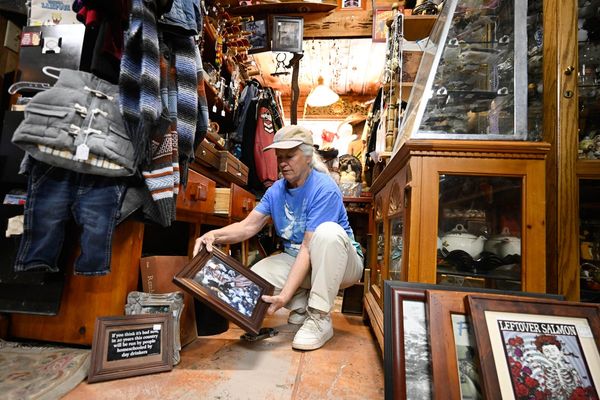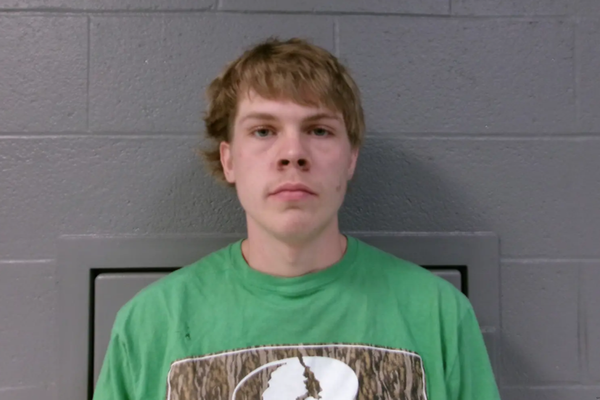
A mist of fine dots spreads across the pale face, with its distinctive moon shape. Scimitar eyebrows rise above a lowered gaze. The half-open mouth is kissably soft, and the hair still lies in a boyish fringe. Francis Bacon is 78 years old, but has made himself 25 once more. You would recognise him any time, anywhere.
This strange and captivating self-portrait hangs at the entrance to Francis Bacon: Human Presence at the National Portrait Gallery – a peculiarly misleading start to the “first exhibition in nearly 20 years to focus on his portraits”. What else did Bacon paint but human animals, more or less? It seems an odd exercise to single out these 55 paintings as portraits, not least because the one recognisable face is Bacon’s own.
It is true that some titles half-promise a portrait – Study for a Pope, Seated Woman, Study for a Portrait. It is also true that others name a lover – the former pilot Peter Lacy, who whipped and beat Bacon; the former boxer George Dyer, who killed himself in their hotel room, aged 37; the bartender John Edwards, who died of cancer at 53. Still others depict female friends: artist Isabel Rawsthorne, writer Henrietta Moraes and Muriel Belcher, proprietor of the Colony Room Club. But how useful is the word depiction?
If it weren’t for the fabulous period photographs threaded through this show, could you really tell Rawsthorne from Belcher, say, or Frank Auerbach from Lucian Freud? Faces materialise out of darkness, or deeply stained colour: squashed, contorted, twisted, swerving, totally plastic and amorphous, yet so suavely defined that you wonder how on earth Bacon does it. Look closely into each picture, and you can see how he works the paint into blurs and fades, swipes and evaporations, scumbled lines, energetic swipes, pristine discs and hyphens, but not how these transitions occur. He remains the most mysterious of conjurors.
The show starts with men in black, sometimes screaming, occasionally caged, always solo. A mouth opens in a yowl, the top of the head missing in the seething nightclub blackness; a drinker in a sharp suit leans on a contour line suggesting a bar. I don’t know who they are, and I doubt the curators do either. They could be Peter Lacy or Ronnie Kray, or even Kenneth Williams; Bacon can veer quite dramatically from agony to Carry On comedy, especially when the teeth inside the howling mouth are pearly white and tiny.
And the effort to find lesser-known Bacons sometimes produces outright farce at the NPG. A very cheery pope in orange, pink and green burbles across the gallery from Bacon’s ludicrous reprise of Van Gogh’s Self-Portrait With Bandaged Ear; as if Vincent hadn’t suffered enough.
But soon we are in Bacon’s own familiar world: those flat backdrops of glowing darkness and architectural sketch lines that hint at nameless bedrooms, cells or bars; those faces that look as if they have been squashed sideways with the violent flat of a hand; one good eye, the other blotted out behind shattered Battleship Potemkin glasses.
Muriel Belcher appears three times in a sequence, turning like a gyre, with her pencilled eyebrows, high forehead and thinning hair. John Edwards sits in his underpants in a chair, casting a pink shadow shaped like one of Lynn Chadwick’s flightless bronze birds. Henrietta Moraes lies on a ticking mattress in the nude, body corkscrewed, black circles on knees and buttocks, features scrambled to oblivion. The image is based on a photograph Bacon commissioned from John Deakin, who sold copies of it to sailors in Soho for 10 shillings a time.
The film-maker John Maybury, in his catalogue essay, has a riveting phrase for the gay community at Belcher’s club when homosexuality was still illegal: “The fearlessness of emboldened alcoholics allowed to shout into the void in a small, nicotine-stained green room.” That gets to the force of Bacon’s art; perhaps even to the composition and colour. The viridian green of the Colony Room seeps, particularly, into images of Peter Lacy, described as the love of Bacon’s life. Not that you have any true sense of that relationship from the small range of closeup heads presented here.
Uneasy, harrowing, claustrophobic: that’s what people say about his art. And at one point Bacon himself is quoted as wondering whether Lacy’s neurosis has somehow crept into the pictures. But how can anyone really tell, when he is as compacted and distorted as everyone else? And what about the ebullience, energy and overwhelming beauty of Bacon’s art?
One revelation of this show may be the significance of colour. Bacon was a sensationally gifted colourist: a sumptuous cobalt blue pours from the bottom of one painting; mauve, gold and papal purple glow from another; scarlet and orange burn so hot they light up the mood as well as the gallery. And Bacon seems to use different palettes for his lovers. He so admired George Dyer’s profile that he made a template to reuse; you see it against midnight blackness, but also against an alizarin crimson that seeps like spilt blood into the canvas, especially in the final triptych of Dyer’s suicide.
The curators seem to want us to discover biography, incident and narrative in these paintings; but such interpretations feel like overlay. If Bacon can base his image of Lucian Freud on a photograph of Franz Kafka, something more (or less) than a portrait is being made. And if one of his own self-portraits incorporates Freud’s body then literal appearance is not at stake. The relationship of these paintings to likeness lies, instead, in their radical similarity to each other at their best – images of life forces so zestful, original and wild they hold their own outside the old conventions of portraiture.
Just in time for Halloween, the South Korean artist Mire Lee has filled the Turbine Hall at Tate Modern with ghosts and ghouls, in the shape of what she calls “skins” stretched tight on metal frames that dangle from the ceiling. Munch’s The Scream, howling banshees, giant spiders, horror-shop masks and flailing spectres swing and flutter in the air. Each is the colour of dried blood, stained by the dye dripping like constant rain from a colossal turbine that slowly turns above us, draped in oozing, flapping tentacles.
Panels explain the references to our industrial past, and the toll it takes on human beings. The skins apparently speak of our anatomy, rammed home by Lee’s title: Open Wound. The whole installation will grow darker with the months, as the dye deepens in hue, and – it is presumably hoped – the metaphorical meaning with it.
It rains, it churns; the skins shiver and multiply. There are 98 of them now, increasing to 150 by next March. But I cannot imagine that the numbers will matter. Nothing looked more fascinating in closeup, nothing developed, nothing further presented itself to eye, ear or mind than the spectacle of it all on entry, which was sheer mechanical hokum.
Star ratings (our of five)
Francis Bacon: Human Presence ★★★★
Hyundai Commission: Mire Lee: Open Wound ★★
Francis Bacon: Human Presence is at the National Portrait Gallery, London, until 19 January 2025
Hyundai Commission: Mire Lee: Open Wound is at the Turbine Hall, Tate Modern, London, until 16 March 2025







